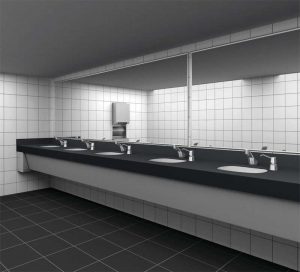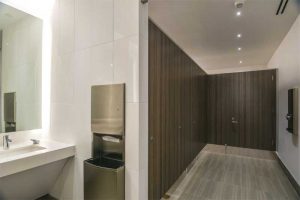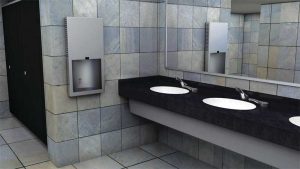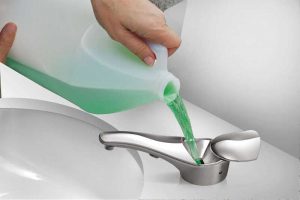Operating commercial restrooms: Designing for authentic, long-term sustainability
by nithya_caleb | June 26, 2019 12:00 am
by David Leigh
 [1]
[1]When architects are tasked with envisioning a brand-new building, with the potential to earn a Leadership in Energy and Environmental Design (LEED) certification, it should be designed with sustainability in mind every step of the way, from the cladding materials on the wall panels to its energy-efficient lighting system. However, once the infrastructure is in place, how is the building to be operated in a responsible and sustainable manner? Do the specification decisions support a long-term sustainability and cost-savings plan?
Sustainable operation should factor into the scope of modern restroom planning and design. It is not only friendlier for the environment, but also closely linked to economical operation, providing architects with opportunities to support their clients’ long-term business goals. ‘Authentic sustainability’ requires design professionals to consider operational strategies beyond those typically associated with ‘green’ buildings.
In addition to LEED certification, many incentives exist for ‘green’ projects, including the design professional’s or the firm’s reputation. Crafting a building that is both built with sustainable materials and constructed to operate sustainably for years, can vastly improve client relationships and foster a positive reputation in the industry. Further, architects who want their design intent—aesthetically, experientially, or operationally—to have a lasting impact, will be well-served by materials saving time, resources, and money, thereby becoming less likely to be replaced by the building owner over time.
Benefits of sustainable operation for building owners
The benefits of sustainable buildings are well known. For instance, using responsible materials may protect the environment and sensitive ecological systems. However, depending on product selection, some ‘green’ buildings also can reduce the costs and resources associated with consumables (i.e. soap and paper towels), energy, water, waste disposal and management, janitorial services, and more.
Operating a sustainable building also can support positive public relations and boost employee or tenant morale, especially if the building is LEED-certified. In fact, studies[2] show, tenant satisfaction scores are higher in buildings achieving LEED or other sustainability benchmarks.
Buildings catering to younger professionals have much to gain from operating sustainably. A study[3] conducted by research firm Lightspeed in 2017 revealed, nearly one in 10 millennials would quit their jobs if they found out their current employer was not operating a sustainable facility. Additionally, nine in 10 millennials believe it is important to work for a sustainable company, compared to 84 percent of Gen Xers and 77 percent of baby boomers.
Sustainable operation: Challenges and solutions
With the benefits of sustainable product specification in mind, it is important to give thoughtful consideration to products saving money, resources, energy, and labor while reducing waste.
Soap dispensers
An inappropriate soap dispensing system can lead to excess plastic packaging waste. Cartridge soap dispensing systems require small, individual, proprietary plastic soap containers (i.e. only the dispenser manufacturer’s own soap cartridges are compatible), thus reducing the facility manager’s purchasing freedom, in addition to producing plastic packaging waste that eventually ends up in landfills.
These proprietary systems are often refilled from beneath the counter, requiring the removal of vanity support brackets or panels required by the Americans with Disabilities Act (ADA) and resulting in strain on the janitorial staff. Further, cartridge systems tend to empty faster, and due to the small size of the cartridges, janitorial staff must refill them more frequently.
However, some soap dispensers feature thoughtful design that actually simplifies maintenance. Large soap dispensers are non-proprietary systems enabling the use of bulk universal soap because it can be bought in 4-L (1-gal) containers on the open market free of proprietary soap-purchasing contracts. These soap systems also can often be refilled from the top of the dispenser, saving time, reducing labor-intensive replacement, and virtually eliminating the disposal of partially filled cartridges.
Finally, many dispensers utilize foam soap, which is generally more sustainable than the liquid variety. Due to the more extensive hand coverage foam soap offers, patrons tend to use less foam than liquid to achieve the equivalent hand-wash.
Paper towel dispensers
 [4]
[4]Photo © Brett Drury
Paper towel dispensers are another common source of inefficiency. Many roll paper towel systems produce what is known as a ‘stub roll’ at the end of each roll. This stub roll comprises a portion of unused paper towels that is typically discarded. They also accumulate over time and contribute to unnecessary waste.
Dispensers without portion control features are also culprits, allowing patrons to dispense handfuls of towels at a time. Many units have adjustable pull lengths and portion control features to limit the amount of product dispensed per use. Some units also utilize shorter second pull lengths and delayed second activation to further discourage wasteful dispensing. Additionally, units equipped with stub roll utilization functionality can ensure every roll goes its furthest, providing complete consumable usage with less replacement time.
Similar to soap dispensers, many roll towel systems can permit open market purchasing freedom and cost savings by allowing facilities to utilize non-proprietary paper towels at a lower cost.
Deciding between roll and folded paper towel dispensers is another consequential specification decision that should be considered based on building occupancy. While roll paper towel dispensers tend to be the more sustainable option, many facilities prefer folded paper towels due to the elimination of stub roll waste. Also, employees often use folded paper towels at their workstations to remove makeup, grab door handles, and clean minor spills because they are more absorbent than roll towels.
Folded paper towel systems can also be equipped with paper towel-saving accessories to eliminate handful dispensing, ensuring only one towel is dispensed at a time. Folded towel dispensers also tend to be low profile, which can be appropriate when a minimalistic design aesthetic is desired, but recessed installation of a roll dispenser is unviable.
Hand dryers
Over the past several decades, hand dryers have become a popular option to complement or replace paper towel dispensers in some restrooms. They reduce waste as well as the need to manage an inventory of paper towels. In some buildings, hand dryers can result in cost savings compared to paper towel systems.
While hand dryers solve many sustainability challenges, other factors come into play. For example, wattage and functionality of hand dryers, and other accessories, can lead to high energy costs, reducing their impact.
In recent years, evolving consumer preferences have driven the demand for hand dryers with quicker dry times. Thus, high-speed hand dryers, also known as jet dryers, have increased in popularity. These models provide a faster hand-dry and hasten traffic flow in the restroom, improving efficiency.
However, many high-speed dryers run on high wattages and can lead to high energy bills, though recent innovations have yielded high-speed, energy-efficient designs. Moreover, newer technologies can have wattages as low as 200 kW and longer life expectancies, operating for as long as 7500 hours (or 10 years) in high-traffic environments, leading to reduced replacement cycles and further savings for the owner.
It should be noted the hand-drying solution should be appropriate for the needs of the building and its occupancy. For example, hand dryers may not be permitted in some facilities, in which case an efficient paper towel dispenser may help optimize operations. In other scenarios, both hand dryers and paper towels may be appropriate to provide the required flexibility.
Where hand dryers are used, it is essential to take a holistic approach to product selection. Before specifying a hand dryer, design professionals must consider the needs of the building occupancy in concert with product features like wattage, design, hygiene considerations, and noise levels.
Lighting
Lighting can be a significant contributor to high energy costs. In many commercial restrooms, the lights remain on at almost all times, regardless of the restroom being in use or not. This leads to high electrical costs, a fact compounded with the high cost of fluorescent or incandescent light bulbs. Fluorescent and incandescent lights are extremely inefficient by today’s standards, and 90 percent of the energy output from these light bulbs goes toward heat, while only 10 percent produces actual light. This is one reason why high-wattage bulbs, fixtures common among incandescent bulbs, are gradually becoming less readily available. Fluorescent lights are also known to spread light in all directions, leading to wasteful and significant energy draw.
In contrast, light-emitting diode (LED) lights use 75 percent less energy than incandescent lights, and the lower amount of heat produced could help substantially reduce HVAC running cost. Further, LEDs are directional in light emission, so they ‘throw’ light exactly where it is needed. LEDs can have up to 50,000 maintenance-free hours of useful life compared to a lifespan of around 10,000 hours for fluorescent lights (The useful life of a light-emitting diode (LED) light is defined as the time it takes for the light output to reach 70 percent of the initial output.). Finally, while fluorescent lights take time to get to full brightness, LEDs illuminate instantly.
The vanity is another opportunity to efficiently light the restroom. LED mirrors can support an elegant, modern aesthetic that enhances and simplifies vanity design while providing ample lighting at a low-energy cost.
Touchless accessories
 [5]
[5]Photo courtesy Bobrick Washroom Equipment, Inc.
Touchless accessories have virtually become standard to sustainable restroom design in 2019 due to their hygienic function and ability to minimize water and consumable usage.
Though automatic products are beneficial for reasons ranging from hygiene to consumable savings, energy requirements should be factored into planning. Many automatic accessories require batteries to operate, which can be another factor contributing to excess waste and energy costs. Other fixtures may need to be hardwired or require metered power source, which can contribute to electric bills.
It is also important to note there are two primary types of hands-free sensors employed in no-touch accessories: the infrared and the less-common fiber optic. Infrared sensors, despite their popularity, can result in wasted water, soap, or other consumables, as they utilize an arc-shaped beam that may not always deactivate properly. Meanwhile, fiber-optic sensors tend to be more reliable, leading to less waste and frustration by patrons.
Touchless faucets can also help improve operations—manually operated ones may result in excessive water use, and while in a rush, patrons may leave them running. Inefficient flow in the faucet’s output can compound excessive water usage.
Similarly, manual toilets and/or urinals can also contribute to unsustainable water usage. Specifiers should note, while automatic flushing systems are generally more sustainable, faulty or ineffective sensors can cause false or ineffective flushes.
Water conservation standards
Touchless operation and sensor technology aside, plumbing fixtures can have a considerable impact on water usage in the restroom.
Today, faucets are available with a variety of spray patterns and flow ranges as low as 0.5 gallons per minute (gpm). Metering faucets can also reduce water usage, as they are engineered to prevent run-on by timing out after a short time interval, reducing waste by almost 50 percent. Some faucets feature adjustable cycle times, typically between 10 and 15 seconds. They are suitable for high-traffic restrooms and those prone to vandalism.
Toilet flow rates can also contribute to sustainable operation. While the industry standard for toilets is 1.6 gallons per flush (gpf), high-efficiency toilets (HETs) can use less than 1.3 gpf. The industry standard for urinals is 1 gpf, with high-efficiency urinals (HEUs) performing at less than 0.5 gpf. Specifiers should consider flow rates in conjunction with automatic sensor types and the building occupancy to optimize operation.
To further aid water conservation, waterless urinals are available, providing superior odor containment and enhanced hygiene. In fact, waterless urinals can contribute up to four LEED points for reducing water waste. Another water-free option, composting toilets, leverage the natural process of organic decomposition to convert waste into compost, which can later be used as soil in gardens. However, waterless or ‘dry’ toilets and urinals may be more difficult or time consuming to maintain and sanitize.
Design implications of sustainable operation
 [6]
[6]As with any specification decision, conducting appropriate research on sustainable product choices is crucial, as the operational inefficiencies of materials can be costly, for the building owner and the designer’s vision. When design professionals do not sufficiently assess their options and specify products that do not function responsibly, the restroom may quickly become difficult to manage.
For building owners, time wasted on product maintenance is money lost. For example, replacing the cartridges in soap dispensers can require janitorial staff to bend under the counter frequently to replace half-full cartridges. Such was the case at one high-traffic convention and entertainment center on the West Coast. Noticing money was being lost due to inefficient soap dispenser design, a new, chrome-finish bulk foam soap dispenser with top-fill functionality was specified to eliminate waste in both time and product while supporting high-end aesthetics.
As a result, more than 300 units were installed, and all the expenses related to soap dispenser operation and maintenance were reduced by more than 80 percent. Had a less sustainable, but equally aesthetic product been specified, the building owner—shortly into the restroom’s life cycle—may have replaced it with a plastic, wall-mounted dispenser, compromising the design intent of the architect.
Communicating the value of sustainability
As the key decision-maker in product specification, it is standard to provide support materials such as building information modeling (BIM) analyses, technical data, and compliance documentation to support specification decisions. Just as important is fully detailing the long-term value of products that architects specify to appropriate project stakeholders. This is crucial, as each stakeholder, from contractors to facility management personnel, has the ability to challenge or value-engineer products out of the specification if they feel the materials will fail to make a substantial impact on facility operations.
Consumable, water, and energy savings should be outlined and communicated, as well as product durability. Materials with the ability to withstand heavy use over extended periods of time reduces replacement and repair costs and extends product life cycles, minimizing the project’s manufacturing footprint, from transportation to raw materials.
Today, innumerable building products are marketed as ‘sustainable.’ Authentic, long-term sustainability should be considered just as important as eco-friendly materials. It is important to note, many building products marketed as sustainable are manufactured overseas, resulting in higher transportation costs and environmental impact. In the author’s experience, domestically manufactured products often can have a more positive net environmental impact than sustainable materials produced overseas.
Understanding and communicating the operating value of each product, including measurable cost and resource savings, can be the deciding factor in securing the specification. By considering strategies beyond those typically associated with green building, architects can achieve their design vision and make it last.
David Leigh is vice-president of marketing at Bobrick Washroom Equipment, Inc. He had previously served as director of sales & marketing of Koala Kare Products prior to Bobrick’s 2004 acquisition of the commercial child care product company. He can be reached at dleigh@bobrick.com[7].
- [Image]: https://www.constructionspecifier.com/wp-content/uploads/2019/06/Restroom.jpg
- studies: http://www.prnewswire.com/news-releases/tenant-satisfaction-sustainability-link-revealed-in-dtz-research-300037064.html
- study: http://www.lightspeedresearch.com/two-three-millennials-give-social-media-everyone-company-recycled
- [Image]: https://www.constructionspecifier.com/wp-content/uploads/2019/06/PaperTowel.jpg
- [Image]: https://www.constructionspecifier.com/wp-content/uploads/2019/06/HandDryer.jpg
- [Image]: https://www.constructionspecifier.com/wp-content/uploads/2019/06/SoapDispenser.jpg
- dleigh@bobrick.com: mailto:dleigh@bobrick.com
Source URL: https://www.constructionspecifier.com/operating-commercial-restrooms-designing-for-authentic-long-term-sustainability/